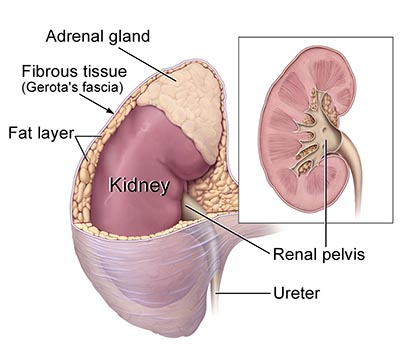Adrenal Tumors
 The adrenal glands sit atop each kidney and produce hormones that give instructions to virtually every organ and tissue in your body.
The adrenal glands sit atop each kidney and produce hormones that give instructions to virtually every organ and tissue in your body.
Two types of problematic tumors can originate in adults’ adrenal glands. Adrenal tumors are very rare.
- A pheochromocytoma is an adrenal tumor that develops in the center of the adrenal gland and produces excess adrenaline, leading to extremely high blood pressure. About 800 new cases are diagnosed in the U.S. each year. Left untreated the high blood pressure can cause a heart attack or stroke. Many patients with high blood pressure (hypertension) caused by pheochromocytoma experience severe headaches, profuse sweating, and palpitations. Hypertensive episodes can be sudden or long-lasting.
- Cancerous tumors of the adrenal gland are extremely rare, affecting only about 300 to 500 people each year in the U.S. They often behave aggressively and can produce excess hormones, causing a wide variety of symptoms.
Testing and Treatment
Most problematic adrenal tumors are treated with medication to control symptoms and followed by surgery to remove the tumor. Surgery is done laparoscopically through a few small openings rather than through a traditional surgical incision.
Surgery corrects most cases of pheochromocytoma.
Large cancerous adrenal tumors are difficult to cure with surgery alone so patients are often treated with additional therapies including medications, radiation therapy, or chemotherapy, alone or in combination.
Frequently Asked Questions
If I have a tumor in one adrenal gland, will the other adrenal gland be affected?
Most adrenal tumors occur in only a single adrenal gland but occasionally both glands are affected.
Can my body function normally with only one adrenal gland?
If a problematic adrenal gland is removed, the remaining healthy gland can carry out the functions that the two glands had performed.





